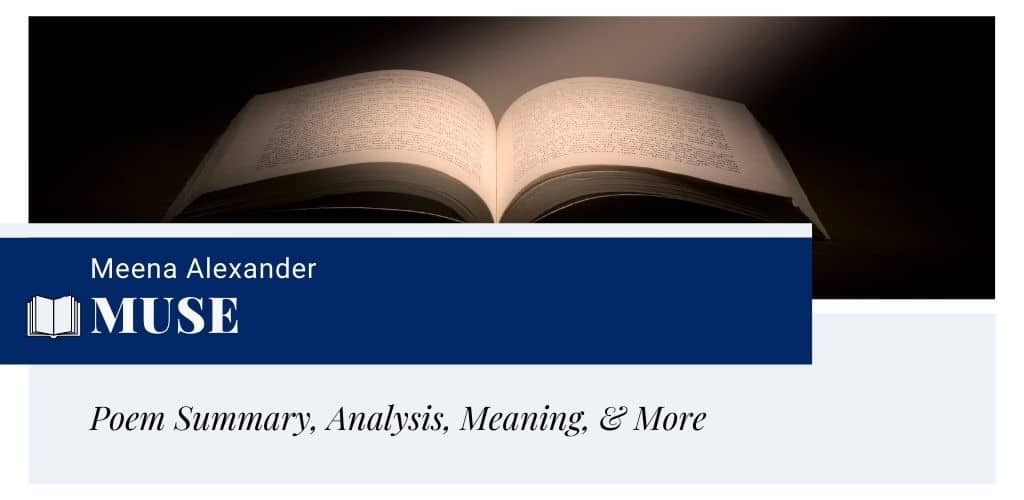Muse by Meena Alexander
“Muse” is written by Indian poet Meena Alexander. This poem appears in her 2002 poetry collection, Illiterate Heart. Through the title of the poem, it seems that Alexander is going to talk about Greek muses. However, the case is otherwise. In this piece, she explores how she came across her muse in the form of a schoolgirl who gave her the themes of her creative works. She inspired the poet to pen down her thoughts in the language that the earth contains. The overall poem is based on this context.
- Read the full text of “Muse“

Summary
The poem “Muse” is about how Meena Alexander found her muse in the form of a girl, dressed in a school uniform. She gave her three things or the themes of her future creative ramifications. These things include a girl, tree, and book.
In the following lines, her poetic persona describes what happened with her afterward. She uses beautiful imagery to describe the monsoon. It seems the poet might have come across her muse in this season.
Furthermore, the creature told her to write in any language that is fit for her creative thoughts. That’s why readers can find the use of Tamil terms (penne, pusthakam, and maram) in this poem.
Meaning
The title of this piece contains a reference to the Greek muses. They are the inspirational goddesses of literature and other fields of study. In this poem, Alexander talks about her muse or the person who inspired her to try her hands on the art of poetry and other literary forms. It seems the muse is none other than the things that she got while brought up. Whatsoever, to create an imaginative atmosphere, she describes how her inspiration came in the form of a schoolgirl and gave her three things, a book, girl, and tree.
Structure, Form, & Rhyming
This poem is written in free-verse. It means the lines of this piece do not contain a specific rhyme scheme or meter. Regarding the point of view, it is written from the perspective of a first-person speaker or Alexander’s poetic persona. The overall poem consists of six sestains or stanzas having six lines each. Though the poem does not have a rhyme scheme, it is not monotonous due to the presence of internal rhymings. Regarding the meter, it consists of both the iambic and trochaic feet with a few variations.
Literary Devices & Figurative Language
Alexander’s “Muse” contains the following literary devices:
- Enjambment: It occurs throughout the poem. For example, in the first stanza, lines 2-6 are enjambed to maintain the flow and connect the ideas.
- Simile: The line “dressed like a convent girl” contains this device.
- Asyndeton: Alexander does not use conjunction from lines 4-6. It is a use of asyndeton.
- Alliteration: It occurs in the following phrases: “rosewood room,” “cloud cover,” “pusthakam pages,” etc.
- Anaphora: It occurs in the following lines: “the self in a mirror in a rosewood room/ the sky at monsoon time, pearl slits”
Stanza-by-Stanza Analysis & Explanation
Stanza One
I was young when you …
… white blouse.
The poem begins directly with a reference to the muse of the poet. Meena Alexander first encountered her source of creativity at an early age. Through the first line, it becomes clear that the poem is not about Greek muses. It is a personal piece in which she shares her first encounter with her muse.
She wrote about the incident after a long time. So, she writes “Each thing rings its turn”. It means each thing that happened is still clear in her memory. Firstly, the goddess nudged her by singing a song, soft and mild. It encapsulated her mind. Suddenly, she witnessed the creature in the form of a convent girl.
She wore white socks, shoes, a dark blue pinafore, and a white blouse as a school-going girl wears. “Pinafore” is a sleeveless garment similar to an apron. It is worn over a young girl’s dress to keep them clean. From this reference, it seems that the muse was one of her schoolmates.
Stanza Two
A pencil box in hand: …
… monsoon time, pearl slits
In the second stanza, Alexander talks about the things she gave to her. She gave her three words, “girl”, “book”, and “tree”. Besides, the girl had a pencil box in her hand. This phrase supports our anticipation stated above. She was surely one of her best friends at school.
In the following lines, Alexander uses the Tamil term “penne” which means a girl. So, her muse was actually a Tamil girl who read with her. Her hair was drawn back and gleaming on the scalp for the use of coconut oil. This image reflects a typical image of a school-going girl in India.
To describe her visage further, the poet uses some metaphors. She compares her to a mirror in a rosewood room. The poet discovered herself in that mirror. Besides, she was like the monsoon sky. This metaphor describes the nature of her friend. She was like the cloudy sky that makes one thoughtful at the same time monotonous.
Stanza Three
In cloud cover, a jagged …
… dreamt its shadow there
The last part of the previous stanza “pearl slits” is enjambed with the first line of this stanza. To describe her muse further, she uses the imagery of rain. She compares each raindrop to a “pearl” that slits in cloud cover. It means that the girl was like a “pearl” hidden in cloud cover.
The girl was an inspiration to her. She gave her a gold-bound book. It was a “raw covenant” of their friendship. In the following lines, she refers to the Tamil term “pusthakam” for a book. It means she had been introduced to this word by the girl.
The misty ink of the book hints at the age of the book. It was quite old as its ink had started to fade. But, while the young poet looked at the content of the book, it appeared as a dreamy shadow of a bird.
Stanza Four
spreading fire in a …
… under a tree.
The fourth stanza begins with a reference to the poet’s imagination concerning the book. She imagined the bird spreading fire in a tree. Thereafter, she refers to the term “Maram” meaning a tree in Tamil.
She spoke of the word and introduced her to a new world through the book. It made her think how “a girl could turn/ into a molten thing and not burn.” Through these lines, Alexander is talking about how she first felt the creative spark within her heart. After entering into the imaginary world for the first time, she metaphorically turned into a molten thing or a flammable liquid. It is a reference to her mind. Creativity ignites this molten thing.
In the last two lines, the poet takes readers to the present. She waits beneath a tree after being worn out from the long journey of her life.
Stanza Five
You come …
… mirror’s edge
Her muse reappears but this time in the form of a bird with golden feathers. It is shedding its feathers. Each quill scrapes her tympanum. The eardrums in humans are called a tympanum. By this line, the poet is referring to the fact that the bird inspires her to write poetry. In the following lines, she refers to the book that her muse gave her. She shares how closely she is attached to the book. Each night she looks at the book by standing at the mirror’s edge.
Stanza Six
alphabets flicker …
… pure transport.
The letters of that book are like birds to the poet. Here, she uses a metaphor by comparing alphabets to birds. The letters flicker and soar high in the poet’s imagination. Generally, words cannot fly. Through this line, the poet is talking about how the book made her fly in her imagination. It gave her wings of creativity. She rose higher in her imagination by flickering those wings.
In the following lines in italics, she alludes to what the muse told her. She advised her to, “Write in the light … of all the languages …” Each language has its own complexity and magic. The poet should not bound her thoughts in the boundaries of a single language. She has to explore her thoughts in other languages that the earth contains.
The muse’s advice enabled her to think differently. It made her explore the different linguistic mediums while expressing her creative energy in verse.
Historical Background
Meena Alexander’s lyrical poem “Muse” was first published in her poetry collection, Illiterate Heart. It was among her best-known works. The book was published in 2002 and won the PEN Open Book Award in the same year. Meena Alexander was born and brought up in India and Sudan. Later, she moved to New York City and worked as a professor there. In this piece, she shares one of her childhood experiences while she was living in Kerala, India. There she encountered her muse in the form of a schoolgirl who inspired her by giving her a book. The girl made her familiar with the Tamil language.
Questions & Answers
Meena Alexander’s poem “Muse” was published in 2002 in her poetry collection Illiterate Heart.
The poem is about how the poet came across her muse in her childhood while she was staying in Kerala, India.
The speaker of this piece is the poet Meena Alexander herself. She speaks through her persona.
The muse is one of her childhood friends who made her familiar with the world of creativity.
The poem taps on themes of childhood, creativity, imagination, and poetic inspiration.
Similar Poems about Childhood & Inspiration
- “Fear” by Gabriela Mistral – It’s about a mother’s fear of her child’s future.
- “A Sad Child” by Margaret Atwood – It’s dedicated to children who are sad or feeling discouraged about some unfortunate events.
- “Winter-Time” by Robert Louis Stevenson – It’s all about a child’s love for the wintry landscape.
- “When my play was with thee” by Rabindranath Tagore – It’s addressed to the supreme being and describes a child’s proximity to God.
External Resources
- About Meena Alexander — Read more about the poet and her works.
- Meena Alexander’s Poet Profile & Poems — Explore the poet’s profile and her poems.
- Journeys, an Interview with Meena Alexander — Read about the thoughts of the poet on writing and postcolonialism.
- An Interview with Meena Alexander, The Kenyon Review — Read the poet’s interview by Ruth Maxey.
- Who were the Muses? — Learn about the Greek muses and their role in mythology.

